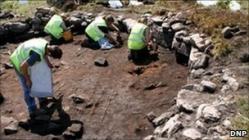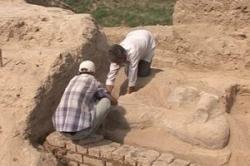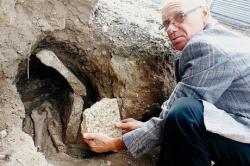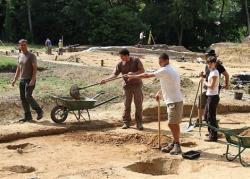- 18 JUILLET
- INDI-UNI : 
PRE-INSCRIPTION : 15 Juin – 15 Août
PRE-REGISTRATION: June 15th - August 15th
- INDE – Chandrapur - Authorities here have said they would take up with the State Archeology Department the issue of reported demolition of four ancient Buddhist caves during mining activities.Amid reports that the four caves, located around 3 kms from here, were destroyed during the routine mining activity of the Mana Opencast Mines of Western Coalfields Limited.
http://news.in.msn.com/national/article.aspx?cp-documentid=5296971
- ROYAUME UNI –  Dartmoor - A team of archaeologists are to start excavating a Bronze Age round house on Dartmoor. The dig in Bellever will explore the entrance and exterior of the home which it is believed farmers lived in. Previous excavations uncovered a paved stone floor, post holes which would have supported a roof and more than 150 shards of pottery. Fragments of burnt oak have also been analysed revealing it was occupied for about 400 years, from 1,600BC.
Dartmoor - A team of archaeologists are to start excavating a Bronze Age round house on Dartmoor. The dig in Bellever will explore the entrance and exterior of the home which it is believed farmers lived in. Previous excavations uncovered a paved stone floor, post holes which would have supported a roof and more than 150 shards of pottery. Fragments of burnt oak have also been analysed revealing it was occupied for about 400 years, from 1,600BC.
http://www.bbc.co.uk/news/uk-england-devon-14178620
- KYRGUISTAN –  Bishkek - Archeologists in Kyrgyzstan have unearthed a large Buddha statue, in the hills outside the capital Bishkek. Archaelogists from the Kyrgyz Academy of Sciences, working with colleagues from the Russian Hermitage Museum in St Petersburg, were digging at a site thought to be the remains of a Buddhist monastery complex. The newly discovered Buddha statue is 1.5 metres tall (almost 5 feet), and depicts the Buddha sitting in the lotus position. The Buddha statue is believed to date back to a time between the 8th to 10th century. Finding Buddhist remains of this kind is rare in the mountainous regions of Kyrgyzstan. Pre-Islamic Buddhist culture is well documented further south in Tajikistan, but very unusual in its northern neighbour, Kyrgyzstan. Locals are accustomed to the excavations, knowing very well that their farm land is in a rich archeological area. In earlier excavations at the same site near the village of Krasnaya Rechka, archaeologists have discovered remains of a Buddhist temple, a fortress, a Karakhanid palace complex, and Buddhist as well as early Christian cemeteries.
Bishkek - Archeologists in Kyrgyzstan have unearthed a large Buddha statue, in the hills outside the capital Bishkek. Archaelogists from the Kyrgyz Academy of Sciences, working with colleagues from the Russian Hermitage Museum in St Petersburg, were digging at a site thought to be the remains of a Buddhist monastery complex. The newly discovered Buddha statue is 1.5 metres tall (almost 5 feet), and depicts the Buddha sitting in the lotus position. The Buddha statue is believed to date back to a time between the 8th to 10th century. Finding Buddhist remains of this kind is rare in the mountainous regions of Kyrgyzstan. Pre-Islamic Buddhist culture is well documented further south in Tajikistan, but very unusual in its northern neighbour, Kyrgyzstan. Locals are accustomed to the excavations, knowing very well that their farm land is in a rich archeological area. In earlier excavations at the same site near the village of Krasnaya Rechka, archaeologists have discovered remains of a Buddhist temple, a fortress, a Karakhanid palace complex, and Buddhist as well as early Christian cemeteries.
http://english.ntdtv.com/ntdtv_en/news_asia/2011-07-18/large-buddha-statue-unearthed-in-kyrgyzstan.html
VIDEO = http://www.youtube.com/watch?v=gC5RCYPDSrc
- FRANCE –  Pessac - Comme dans un bon film de Spielberg, l'archéologie est sujette à rebondissements et suspense. Au centre-ville de Pessac, les épisodes se succèdent. À peine, l'historien Jacques Clémens était-il sorti du trou de travaux où il laissait entendre que l'on pourrait trouver des choses intéressantes si on se donnait la peine de chercher que quelqu'un d'autre allait y regarder de plus près. Bingo. Le jour de la parution de l'article (Archeonews 16-17/07), Daniel Daucourt, président de l'Association des amis du beau et vieux Pessac, découvrait un sarcophage. C'est donc le 2e sarcophage découvert au centre-ville, le premier avec un couvercle, même s'il n'est pas entier : « Le fait qu'il soit à l'extérieur de l'église, prouve la richesse de l'ancien cimetière », souligne Jacques Clémens. « Il fallait avoir les moyens pour se payer un sarcophage. Il y en a peut-être d'autres. Le passé de Pessac est très ancien, son toponyme renvoie à une origine celte, ou plus sûrement romaine : Peccius. Des chemins celtes et une importante voie romaine passaient à proximité. Souvent les églises furent bâties sur des temples païens qui n'ont peut-être pas encore dit leur dernier mot, surtout par la bouche de Jacques Clémens : « En 1978, on avait trouvé trace de mûrs fantômes : des tranchées remblayées après récupération des pierres. S'agissait-il d'un vieux mur de l'église ou d'un mur gallo-romain ? » La suite au prochain épisode.
Pessac - Comme dans un bon film de Spielberg, l'archéologie est sujette à rebondissements et suspense. Au centre-ville de Pessac, les épisodes se succèdent. À peine, l'historien Jacques Clémens était-il sorti du trou de travaux où il laissait entendre que l'on pourrait trouver des choses intéressantes si on se donnait la peine de chercher que quelqu'un d'autre allait y regarder de plus près. Bingo. Le jour de la parution de l'article (Archeonews 16-17/07), Daniel Daucourt, président de l'Association des amis du beau et vieux Pessac, découvrait un sarcophage. C'est donc le 2e sarcophage découvert au centre-ville, le premier avec un couvercle, même s'il n'est pas entier : « Le fait qu'il soit à l'extérieur de l'église, prouve la richesse de l'ancien cimetière », souligne Jacques Clémens. « Il fallait avoir les moyens pour se payer un sarcophage. Il y en a peut-être d'autres. Le passé de Pessac est très ancien, son toponyme renvoie à une origine celte, ou plus sûrement romaine : Peccius. Des chemins celtes et une importante voie romaine passaient à proximité. Souvent les églises furent bâties sur des temples païens qui n'ont peut-être pas encore dit leur dernier mot, surtout par la bouche de Jacques Clémens : « En 1978, on avait trouvé trace de mûrs fantômes : des tranchées remblayées après récupération des pierres. S'agissait-il d'un vieux mur de l'église ou d'un mur gallo-romain ? » La suite au prochain épisode.
http://www.sudouest.fr/2011/07/18/sarcophage-decouvert-454592-729.php
- FRANCE –  Allonnes - C'est la dernière semaine de la campagne de fouilles. Après 17 ans de recherches archéologiques estivales, les ultimes coups de truelle sur le sanctuaire antique. Le CNRS avait relancé les fouilles sur le sanctuaire gallo-romain de la Tour aux fées, en 1994. Un programme de grande ampleur sur un complexe religieux monumental. Car du II e au IV e siècles de notre ère, un temple entouré de portiques s'élevait à cet endroit. Cette année, c'est la dernière campagne. « On s'arrêtera deux ans, confie Katerine Gruel, directrice de recherche au CNRS. Puis on reviendra. On espère aussi que le programme de mise en valeur va commencer. » Le temps du bilan scientifique est venu : les résultats exhaustifs de la fouille du grand temple doivent faire l'objet d'une publication. « L'état final du temple, dont le chantier de construction a duré de 80 à 150 ap. J-C, était fréquenté de 160 ap. J-C au 1 er quart du IV e siècle, explique Vincent Bernolin, coordinateur scientifique, qui fouille ici depuis 17 ans. Si on arrête, c'est aussi pour préserver les murs mis au jour, devenus très fragiles. Sur le temps de la publication, il n'est pas raisonnable de les laisser à l'air libre. » Les vestiges les plus sensibles seront ainsi recouverts temporairement. Pour la fouille en tant que telle, on y reviendra plus tard. « Car il y a un énorme potentiel quant aux périodes antérieures au I er siècle, notamment l'époque gauloise, » qu'affectionnent tout particulièrement Vincent Bernolin et Katerine Gruel... De nombreux indices laissent supposer que, sous les vestiges de la période romaine, un grand sanctuaire gaulois sommeille.
Allonnes - C'est la dernière semaine de la campagne de fouilles. Après 17 ans de recherches archéologiques estivales, les ultimes coups de truelle sur le sanctuaire antique. Le CNRS avait relancé les fouilles sur le sanctuaire gallo-romain de la Tour aux fées, en 1994. Un programme de grande ampleur sur un complexe religieux monumental. Car du II e au IV e siècles de notre ère, un temple entouré de portiques s'élevait à cet endroit. Cette année, c'est la dernière campagne. « On s'arrêtera deux ans, confie Katerine Gruel, directrice de recherche au CNRS. Puis on reviendra. On espère aussi que le programme de mise en valeur va commencer. » Le temps du bilan scientifique est venu : les résultats exhaustifs de la fouille du grand temple doivent faire l'objet d'une publication. « L'état final du temple, dont le chantier de construction a duré de 80 à 150 ap. J-C, était fréquenté de 160 ap. J-C au 1 er quart du IV e siècle, explique Vincent Bernolin, coordinateur scientifique, qui fouille ici depuis 17 ans. Si on arrête, c'est aussi pour préserver les murs mis au jour, devenus très fragiles. Sur le temps de la publication, il n'est pas raisonnable de les laisser à l'air libre. » Les vestiges les plus sensibles seront ainsi recouverts temporairement. Pour la fouille en tant que telle, on y reviendra plus tard. « Car il y a un énorme potentiel quant aux périodes antérieures au I er siècle, notamment l'époque gauloise, » qu'affectionnent tout particulièrement Vincent Bernolin et Katerine Gruel... De nombreux indices laissent supposer que, sous les vestiges de la période romaine, un grand sanctuaire gaulois sommeille.
http://www.ouest-france.fr/actu/actuLocale_-Sur-le-sanctuaire-gallo-romain-les-dernieres-fouilles-_72003-avd-20110715-60902526_actuLocale.Htm
- PAKISTAN – Swat Valley - Over 2,700 antiquities of the Gandhara era were today returned to the Buddhist Museum in the Swat valley of northwest Pakistan, which was shutdown following an attack by militants three years ago. The collection includes 250 stone sculptures, 100 statues of Buddha, 1,200 coins, 50 stucco sculptures, pots, burial pottery and life stories of Buddha from birth to death.
http://www.deccanherald.com/content/177078/gandhara-era-antiques-restored-pakistans.html
- USA – Pottersville - It was only a few weeks ago that a team of academic professionals, college students and volunteers gathered from around the world to uncover what mysteries they could from Abner Landrum's kiln site at historic Pottersville, a forgotten community outside today's Edgefield.They traveled to South Carolina with high hopes and departed with raised eyebrows at the massive size of the kiln they uncovered and the nearly 30,000 artifacts that will be examined in the coming months. The project was by all accounts a tremendous success. "We identified the extent of the kiln and all the major features of the kiln, which was one of the main objectives," Calfas said. "When we arrived we thought we were looking for a groundhog kiln, but what we actually discovered was a kiln 105 feet in length. It's an extraordinary find of historical significance." The team used multiple technologies in its search, including mass spectroscopy, artifact reconstruction and mathematical analysis. "Once we took back the brush we knew we had to change our entire mind-set," Calfas said of the group's first days at the site. "We had to abandon the idea of uncovering the entire surface and concentrate on those connection points. Now knowing what we have in this kiln, it really puts the Edgefield District in a different context, and much more as a manufacturing facility rather than a folk tradition." Calfas says he hopes the Pottersville site, which was placed on the National Historic Register in 1977, is eventually elevated to National Landmark status.
http://chronicle.augusta.com/news/metro/2011-07-17/dig-pottersville-site-uncovers-30000-artifacts
- EGYPTE – Le Caire - Egypt's antiquities minister, whose trademark Indiana Jones hat made him one the country's best known figures around the world, was fired Sunday after months of pressure from critics who attacked his credibility and accused him of having been too close to the regime of ousted President Hosni Mubarak. Zahi Hawass, long chided as publicity loving and short on scientific knowledge, lost his job along with about a dozen other ministers in a Cabinet reshuffle meant to ease pressure from protesters seeking to purge remnants of Mubarak's regime.
http://www.google.com/hostednews/ap/article/ALeqM5ijBtFZ08OmsLpDoUeg-YSLO-p1Sg?docId=036d849b7eed4fd4ab3516b948a1f7ad